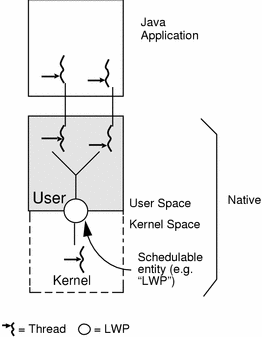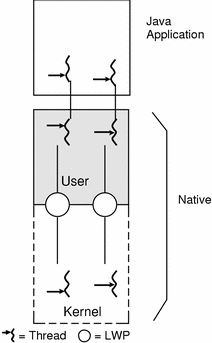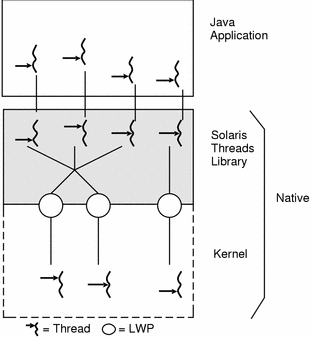Multithreading Models
Most multithreading models fall into one of the following categories of threading implementation:
-
Many-to-One
-
One-to-One
-
Many-to-Many
Many-to-One Model (Green Threads)
Implementations of the many-to-one model (many user threads to one kernel thread) allow the application to create any number of threads that can execute concurrently. In a many-to-one (user-level threads) implementation, all threads activity is restricted to user space. Additionally, only one thread at a time can access the kernel, so only one schedulable entity is known to the operating system. As a result, this multithreading model provides limited concurrency and does not exploit multiprocessors. The initial implementation of Java threads on the Solaris system was many-to-one, as shown in the following figure.
Figure 2-1 Many-to-One Multithreading Model

One-to-One Model
The one-to-one model (one user thread to one kernel thread) is among the earliest implementations of true multithreading. In this implementation, each user-level thread created by the application is known to the kernel, and all threads can access the kernel at the same time. The main problem with this model is that it places a restriction on you to be careful and frugal with threads, as each additional thread adds more "weight" to the process. Consequently, many implementations of this model, such as Windows NT and the OS/2 threads package, limit the number of threads supported on the system.
Figure 2-2 One-to-One Multithreading Model

Many-to-Many Model (Java on Solaris--Native Threads)
The many-to-many model (many user-level threads to many kernel-level threads) avoids many of the limitations of the one-to-one model, while extending multithreading capabilities even further. The many-to-many model, also called the two-level model, minimizes programming effort while reducing the cost and weight of each thread.
In the many-to-many model, a program can have as many threads as are appropriate without making the process too heavy or burdensome. In this model, a user-level threads library provides sophisticated scheduling of user-level threads above kernel threads. The kernel needs to manage only the threads that are currently active. A many-to-many implementation at the user level reduces programming effort as it lifts restrictions on the number of threads that can be effectively used in an application.
A many-to-many multithreading implementation thus provides a standard interface, a simpler programming model, and optimal performance for each process. The Java on Solaris operating environment is the first many-to-many commercial implementation of Java on an MT operating system.
Figure 2-3 Many-to-Many Multithreading Model

- © 2010, Oracle Corporation and/or its affiliates
